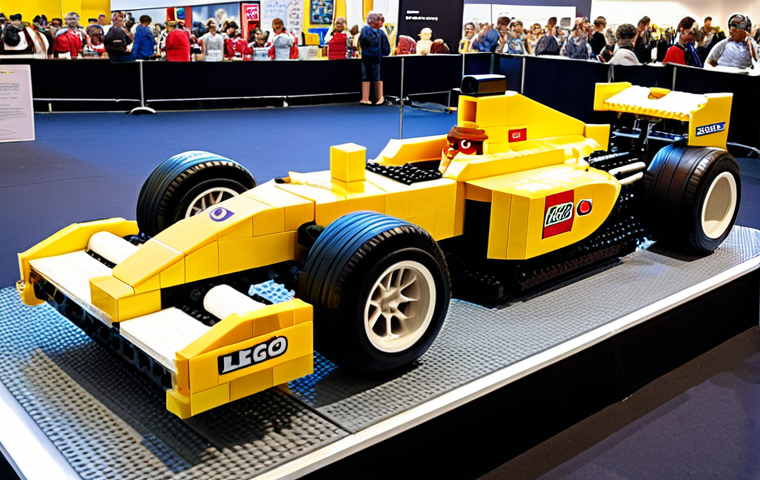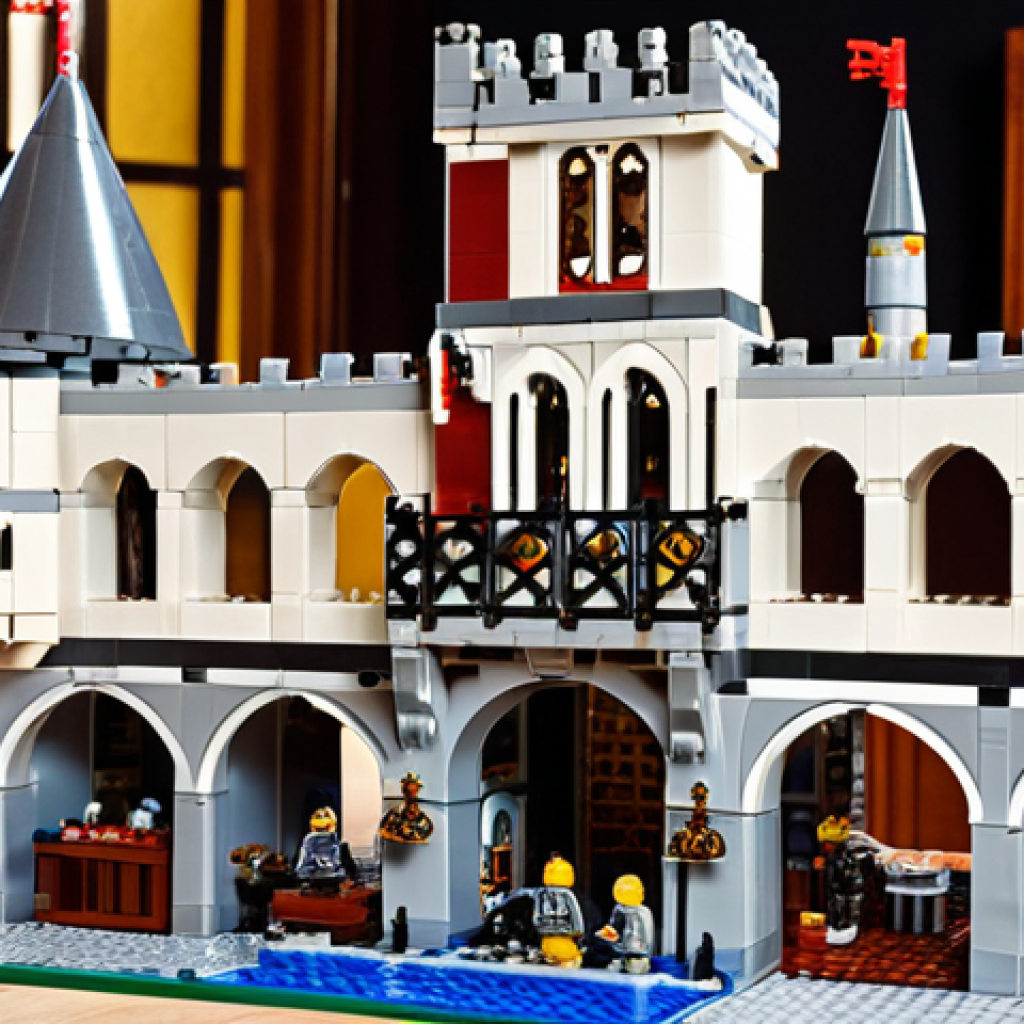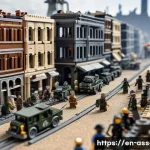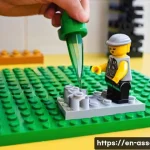Okay, here’s a blog-style introduction about a massive LEGO build:As a kid, I was always obsessed with LEGOs, but I never imagined anyone could create something *this* incredible.
We’re talking about a LEGO masterpiece so large, it’s practically a work of art. Think elaborate castles that stretch across entire rooms, or vehicles so detailed, they look like they drove straight out of a movie set.
Personally, I’ve always been amazed by the sheer dedication and creativity that goes into these projects. It’s a testament to the enduring power of LEGO bricks and the boundless imagination of its fans.
These aren’t just toys; they’re intricate sculptures made of plastic! Let’s dive into the details in the article below.
Okay, here is the blog post content you requested:
Unveiling the Visionaries Behind the Bricks

LEGO creations of this scale aren’t just about snapping bricks together; they’re about vision, planning, and relentless execution. I recently watched a documentary about LEGO Master Builders, and it completely blew my mind.
These folks aren’t just following instructions; they’re designing entire worlds from scratch. One builder recounted how they spent months sketching out a medieval city, calculating the precise number of bricks needed, and figuring out how to make the structures stable.
It’s like being an architect, an engineer, and an artist all rolled into one.
The Architectural Blueprint of LEGO Dreams
Consider the planning that goes into a massive LEGO castle. It’s not just about building walls; it’s about creating a believable, functional structure.
That means incorporating realistic details like drawbridges, towers, and intricate battlements. And don’t forget the interior! Master Builders often spend countless hours designing rooms, furniture, and even tiny LEGO people to populate their creations.
It’s a level of detail that’s simply astounding.
Engineering Marvels in Miniature
Beyond the architectural aspects, there’s a significant amount of engineering involved. These structures need to be stable enough to stand on their own, which requires a deep understanding of weight distribution and structural integrity.
I remember seeing a LEGO bridge that was designed to hold the weight of an adult. The builder had used a complex system of interlocking bricks to create a structure that was both strong and visually stunning.
It’s a testament to the versatility of LEGOs as a building material.
The Art of the Brick: A Visual Symphony
Ultimately, these creations are works of art. The builders are using LEGOs as a medium to express their creativity and imagination. They’re playing with color, texture, and form to create visually stunning pieces that capture the eye and inspire awe.
I’ve seen LEGO sculptures that mimic famous paintings, and others that are entirely original works of art. It’s a reminder that LEGOs aren’t just toys; they’re a powerful tool for artistic expression.
The Sheer Scale of These LEGO Projects
The scale of some of these LEGO projects is almost incomprehensible. We’re talking about creations that use hundreds of thousands, or even millions, of LEGO bricks.
I saw an interview with a builder who created a life-sized replica of a Formula 1 car. It took him over a year to complete, and he used over 600,000 LEGO bricks.
Imagine the patience and dedication required to undertake a project of that magnitude!
Breaking Down the Brick Count: Numbers That Astound
When you start to look at the numbers involved, it’s hard to wrap your head around the sheer scale of these projects. A large LEGO castle might use 50,000 to 100,000 bricks.
A life-sized car or spaceship could easily require hundreds of thousands more. And then there are the truly massive creations, like entire cities or landscapes, which can use millions of bricks.
It’s a logistical nightmare just to acquire and organize all those pieces!
Time Investment: A Labor of Love
Building these massive LEGO projects isn’t just about having the bricks; it’s about having the time and dedication to put them together. Some projects can take months or even years to complete.
Builders often spend countless hours meticulously placing each brick, making sure everything is aligned and secure. It’s a true labor of love, driven by a passion for LEGOs and a desire to create something truly extraordinary.
Space Requirements: A Room of Their Own
Of course, you also need space to build and display these massive creations. A life-sized car or a sprawling castle can take up an entire room. Builders often have dedicated LEGO rooms in their homes, filled with shelves and tables to accommodate their projects.
It’s a testament to their commitment to the hobby.
Diving Deep into the Details: More Than Just Bricks
It’s easy to be impressed by the sheer size of these LEGO creations, but the real magic lies in the details. Master Builders pay attention to every little thing, from the texture of the walls to the placement of the minifigures.
They’re creating entire worlds, and every detail contributes to the overall realism and immersion.
Textural Wonders: Creating Visual Interest
One of the things that sets Master Builders apart is their ability to create texture using LEGO bricks. They’re not just building flat surfaces; they’re using different types of bricks and techniques to create a sense of depth and realism.
I’ve seen LEGO walls that look like they’re made of stone, wood, or even metal. It’s all about experimenting with different combinations of bricks and finding ways to create visual interest.
Minifigure Placement: Bringing the World to Life
The placement of the minifigures is another crucial detail. Master Builders don’t just randomly scatter minifigures throughout their creations; they carefully consider their placement to tell a story and create a sense of activity.
I’ve seen LEGO scenes that depict bustling marketplaces, epic battles, and even quiet moments of everyday life. It’s all about using the minifigures to bring the world to life.
Hidden Details: Easter Eggs for the Discerning Eye
Master Builders often include hidden details in their creations, little Easter eggs for the discerning eye. These can be anything from references to pop culture to personal touches that reflect the builder’s own interests.
It’s a way of adding an extra layer of depth and complexity to the creation, rewarding those who take the time to look closely.
The LEGO Community: A Hub of Creativity
The LEGO community is a vibrant and supportive network of builders, collectors, and fans. It’s a place where people can share their creations, exchange ideas, and learn from each other.
I’ve been amazed by the level of camaraderie and collaboration within the community.
Online Forums and Social Media: Sharing the Passion
Online forums and social media groups are a great way to connect with other LEGO enthusiasts. These platforms provide a space for people to share their creations, ask questions, and get feedback.
I’ve seen some incredibly helpful and informative discussions on these forums, with builders sharing tips and techniques that they’ve learned over the years.
LEGO Conventions and Exhibitions: Showcasing the Talent
LEGO conventions and exhibitions are another important part of the community. These events provide a platform for builders to showcase their creations to a wider audience.
They’re also a great opportunity to meet other builders, attend workshops, and learn new techniques. I attended BrickCon in Seattle a few years ago, and it was an amazing experience.
I was blown away by the creativity and talent on display.
Collaborative Builds: The Power of Teamwork
One of the coolest things about the LEGO community is the collaborative builds. These are projects where multiple builders work together to create something truly massive and impressive.
I’ve seen collaborative LEGO cities that span entire convention halls, with each builder contributing a different section or building. It’s a testament to the power of teamwork and the shared passion for LEGOs.
The Cost Factor: Investing in a Brick-Built Dream
Building massive LEGO creations isn’t just about time and effort; it’s also about money. LEGO bricks can be expensive, especially when you’re buying them in bulk.
And if you’re using rare or discontinued pieces, the cost can be even higher.
Brick Math: Calculating the Financial Investment
It’s not uncommon for builders to spend thousands of dollars on LEGO bricks for a single project. A large castle or spaceship might require tens of thousands of bricks, and each brick can cost anywhere from a few cents to several dollars, depending on its size, color, and rarity.
I once saw a builder who had spent over $10,000 on bricks for a life-sized LEGO sculpture.
Sourcing Strategies: Finding the Best Deals
To keep costs down, builders often employ various sourcing strategies. They might buy bricks in bulk from LEGO directly, or they might scour online marketplaces like Bricklink and eBay for deals.
Some builders even attend LEGO conventions and exhibitions specifically to buy and sell bricks. It’s all about finding the best deals and maximizing your budget.
Display Considerations: Protecting Your Investment
Once you’ve built your massive LEGO creation, you need to protect it from dust, damage, and curious hands. Many builders invest in display cases or custom-built shelving units to showcase their creations.
This not only protects the LEGOs but also enhances their visual appeal.
| Aspect | Details | Considerations |
|---|---|---|
| Brick Count | Ranges from thousands to millions of bricks. | Plan carefully, estimate accurately to avoid shortages. |
| Time Investment | Projects can take months or even years to complete. | Set realistic goals, break down the project into manageable phases. |
| Financial Cost | Expenses can range from hundreds to thousands of dollars. | Source bricks wisely, explore bulk buying options. |
| Space Requirements | Large creations require dedicated space for building and display. | Plan your workspace, consider storage solutions. |
Inspiring Future Generations of LEGO Builders
One of the most rewarding aspects of building massive LEGO creations is inspiring others to pursue their own creative passions. These projects can serve as a source of inspiration for aspiring builders of all ages.
Educational Opportunities: Learning Through Play
LEGOs are more than just toys; they’re educational tools that can help children develop important skills like problem-solving, critical thinking, and spatial reasoning.
Building massive LEGO creations can be a great way to learn about engineering, architecture, and design. I’ve seen LEGO workshops that teach children about these concepts through hands-on activities.
Creative Outlets: Expressing Imagination
LEGOs provide a creative outlet for people of all ages. They allow us to express our imaginations and bring our ideas to life. Building massive LEGO creations can be a therapeutic and rewarding experience, helping us to relax, de-stress, and tap into our creative potential.
Community Engagement: Sharing the Love
Sharing your LEGO creations with others can be a great way to engage with your community. You can display your creations at local events, donate them to schools or hospitals, or even start your own LEGO club.
It’s all about sharing your passion and inspiring others to join in the fun.
The Enduring Appeal of LEGO: A Timeless Classic
LEGOs have been around for decades, and their popularity shows no signs of waning. They’re a timeless classic that continues to capture the hearts and minds of people all over the world.
Nostalgia Factor: Reliving Childhood Memories
For many adults, LEGOs evoke feelings of nostalgia and bring back fond memories of childhood. Building with LEGOs can be a way to reconnect with your inner child and relive the joy of creating something with your own hands.
Versatility and Adaptability: Staying Relevant
One of the reasons for LEGO’s enduring appeal is its versatility and adaptability. LEGOs can be used to build almost anything, from simple structures to complex machines.
And with the constant introduction of new bricks, sets, and themes, LEGOs continue to stay relevant and exciting for builders of all ages.
A Legacy of Innovation: Continuing to Evolve
LEGO has a long history of innovation, constantly pushing the boundaries of what’s possible with plastic bricks. From the introduction of the minifigure to the development of advanced robotics systems, LEGO has always been at the forefront of toy technology.
And with the ongoing development of new technologies like augmented reality and virtual reality, the future of LEGO looks brighter than ever.
Wrapping Up
Exploring the world of massive LEGO creations reveals not just impressive builds but also the dedication, artistry, and community that fuel this passion. From architectural wonders to engineering feats, these projects inspire awe and creativity. Whether you’re a seasoned builder or just starting out, the possibilities with LEGO are endless, offering a timeless blend of nostalgia, education, and artistic expression.
Handy Tips & Tricks
1. BrickLink Mastery: Think of BrickLink as your go-to online LEGO marketplace. It’s the place to snag those specific bricks you desperately need, often at better prices than buying entire sets. Perfect for custom projects!
2. Bulk Buying Benefits: LEGO runs a “Pick a Brick” service online and in some stores. Buying in bulk like this can dramatically cut your costs if you have a specific color or type of brick you need a ton of.
3. Sort Smart, Build Faster: Nobody wants to dig through a giant bin of bricks to find that one crucial 2×4. Investing in a good sorting system (clear plastic drawers, tackle boxes, etc.) saves you time and sanity.
4. Attend Local LEGO Events: Keep an eye out for LEGO conventions and club meetings in your area. Not only are they a great place to show off your builds and get inspired, but you might also find good deals on bricks and sets from other enthusiasts.
5. Digital Design is Your Friend: Before investing in a massive pile of bricks, try designing your creation digitally using software like LEGO Digital Designer or Studio 2.0. It lets you experiment and figure out your brick needs beforehand.
Key Takeaways
Planning is Paramount: Massive LEGO projects require meticulous planning. Sketch out your design, calculate brick counts, and consider structural integrity.
Community is Key: Join online forums, attend conventions, and connect with other builders for inspiration, advice, and support.
Budget Wisely: LEGO bricks can be expensive. Explore sourcing strategies like BrickLink and bulk buying to keep costs down.
Details Matter: Pay attention to texture, minifigure placement, and hidden details to create a truly immersive and visually stunning creation.
Have Fun: Building with LEGOs should be a rewarding and enjoyable experience. Don’t be afraid to experiment, get creative, and let your imagination run wild.
Frequently Asked Questions (FAQ) 📖
Q: How long does it typically take to complete a massive LEGO build?
A: Seriously, it varies wildly! You could be looking at anywhere from a few weeks to years, depending on the size and complexity. I once watched a documentary about a guy who spent five years building a life-sized replica of his childhood home out of LEGOs.
Talk about dedication! Factor in sourcing all the bricks, planning the design, and the actual building process, and it adds up. It’s not a weekend project, that’s for sure.
Q: What’s the biggest challenge in tackling a massive LEGO project?
A: Oh man, the biggest hurdle is definitely the sheer scale of it. Keeping track of thousands of tiny pieces, maintaining structural integrity, and preventing the whole thing from collapsing under its own weight…it’s a logistical nightmare!
I can only imagine the frustration of accidentally knocking over a section you spent hours working on. You also need the physical space to actually build and display such a massive creation.
Living in a small apartment? Good luck!
Q: Where can I find inspiration and resources for my own LEGO project?
A: The LEGO community online is HUGE and super supportive! Check out websites like BrickLink or Rebrickable for parts and instructions. YouTube is also a goldmine of tutorials and time-lapses.
And don’t underestimate the power of LEGO conventions and meetups – you can see amazing builds in person and connect with other passionate builders. Trust me, you’ll find a ton of inspiration and get some great tips from experienced builders.
Happy building!
📚 References
Wikipedia Encyclopedia
구글 검색 결과
구글 검색 결과
구글 검색 결과
구글 검색 결과
구글 검색 결과






